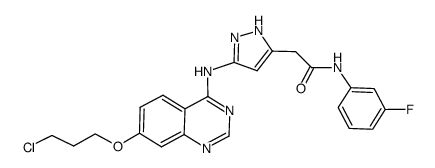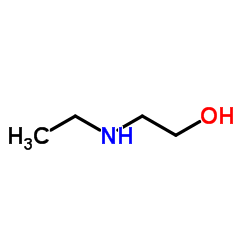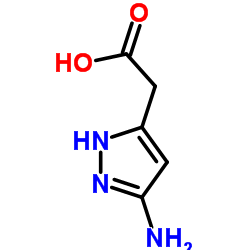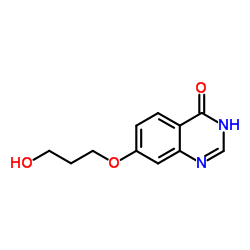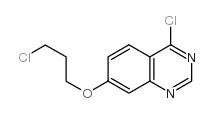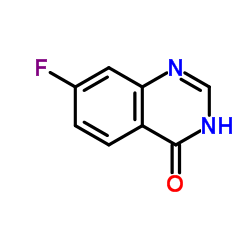722544-51-6
| Name | 2-{3-[(7-[3-[ethyl(2-hydroxyethyl)amino]propoxy]-quinazolin-4-yl)amino]-1H-pyrazol-5-yl}-N-(3-fluorophenyl)acetamide |
|---|---|
| Synonyms |
AZD1152-HQPA
INH 34 AZD-1152-HQPA 2-{3-[(7-{3-[Ethyl(2-hydroxyethyl)amino]propoxy}-4-quinazolinyl)amino]-1H-pyrazol-5-yl}-N-(3-fluorophenyl)acetamide Barasertib 2-{3-[(7-{3-[ethyl(2-hydroxyethyl)amino]propoxy}quinazolin-4-yl)amino]-1H-pyrazol-5-yl}-N-(3-fluorophenyl)acetamide AZD1152 HPQA |
| Description | AZD1152-HQPA is a highly selective Aurora B inhibitor with IC50 of 0.37 nM in a cell-free assay, and appr 3700 fold more selective for Aurora B over Aurora A. |
|---|---|
| Related Catalog | |
| Target |
Aurora B:0.37 nM (IC50) |
| In Vitro | AZD1152 displays >3000-fold selectivity for Aurora B as compared with Aurora A which has an IC50 of 1.368 μM. AZD1152 has even less activity against 50 other serine-threonine and tyrosine kinases including FLT3, JAK2, and Abl. AZD1152 inhibits the proliferation of hematopoietic malignant cells such as HL-60, NB4, MOLM13, PALL-1, PALL-2, MV4-11, EOL-1, THP-1, and K562 cells with IC50 of 3-40 nM, displaying appr 100-fold potency than another Aurora kinase inhibitor ZM334739 which has IC50 of 3-30 μM. AZD1152 inhibits the clonogenic growth of MOLM13 and MV4-11 cells with IC50 of 1 nM and 2.8 nM, respectively, as well as the freshly isolated imatinib-resistant leukemia cells with IC50 values of 1-3 nM, more significantly compared with bone marrow mononuclear cells with IC50 values of >10 nM. AZD1152 induces accumulation of cells with 4N/8N DNA content, followed by apoptosis in a dose- and time-dependent manner[2]. AZD1152-HQPA treatment induces defective cell survival, polyploidy, and cell death in LNCaP cell line. AZD1152-HQPA also decreases expression of AR[3]. |
| In Vivo | AZD1152 (10-150 mg/kg/day) significantly inhibits the growth of a variety of human solid tumor xenografts, including colon, breast, and lung cancers, in a dose-dependent manner[1]. Administration of AZD1152 (25 mg/kg) alone markedly suppresses the growth of MOLM13 xenografts, confirmed by the observation of necrotic tissue with infiltration of phagocytic cells[2]. |
| Cell Assay | Cells are exposed to various concentrations of AZD1152 for 24 or 48 hours. Cell proliferation is measured by 3H-thymidine uptake (isotope added 6 hours before harvest), and the concentration that induced 50% growth inhibition (IC50) is calculated from dose-response curves. Cell cycle analysis is performed by flow cytometry. Cell apoptosis is measured by annexin V–FITC apoptosis detection kit. |
| Animal Admin | Human tumor xenografts are established by s.c. injecting 100 to 200 μL tumor cells (between 1×106 and 1×107 cells mixed 50:50 with Matrigel) on the flank. Animals are randomized into treatment groups (n=8-11 per group) when tumors reach a defined palpable size (0.2-0.3 cm3 and 0.5-1 cm3 for mice and rats, respectively). AZD1152 is prepared in Tris buffer (pH 9) and administered either as a bolus injection (i.v. or i.p.) or as a continuous 48-h infusion via s.c. implanted osmotic mini-pumps (two 24-h pumps implanted sequentially) in accordance with the manufacturer's instructions. Tumors are measured up to three times weekly with calipers, tumor volumes are calculated, and the data are plotted using the geometric mean for each group versus time. Tumor volume and tumor growth inhibition are calculated. Statistical analysis of any change in tumor volume is carried out using a Student's one-tailed t test (P value of <0.05 is considered to be statistically significant). |
| References |
| Density | 1.4±0.1 g/cm3 |
|---|---|
| Boiling Point | 796.7±60.0 °C at 760 mmHg |
| Molecular Formula | C26H30FN7O3 |
| Molecular Weight | 507.560 |
| Flash Point | 435.6±32.9 °C |
| Exact Mass | 507.239410 |
| PSA | 128.29000 |
| LogP | 2.82 |
| Appearance | white to beige |
| Vapour Pressure | 0.0±2.9 mmHg at 25°C |
| Index of Refraction | 1.677 |
| Storage condition | 2-8°C |
| Water Solubility | DMSO: >15mg/mL |
|
SECTION 1: Identification of the substance/mixture and of the company/undertaking Product identifiers Product name: AZD1152-HQPA : SML0268 REACH No.: A registration number is not available for this substance as the substance or its uses are exempted from registration, the annual tonnage does not require a registration or the registration is envisaged for a later
registration deadline. CAS-No.: 722544-51-6 SECTION 2: Hazards identification Classification of the substance or mixture Not a hazardous substance or mixture according to Regulation (EC) No. 1272/2008. This substance is not classified as dangerous according to Directive 67/548/EEC. Label elements This substance is not classified as dangerous according to Directive 67/548/EEC. Other hazards - none SECTION 3: Composition/information on ingredients Substances Synonyms: 3-[[7-[3-[Ethyl(2-hydroxyethyl)amino]propoxy]-4-quinazolinyl]amino]-N-(3- fluorophenyl)-1H-pyrazole-5-acetamide Formula: C26H30FN7O3 Molecular Weight: 507,56 g/mol CAS-No.: 722544-51-6 No components need to be disclosed according to the applicable regulations. SECTION 4: First aid measures Description of first aid measures General advice Consult a physician. Show this safety data sheet to the doctor in attendance. If inhaled If breathed in, move person into fresh air. If not breathing, give artificial respiration. Consult a physician. In case of skin contact Wash off with soap and plenty of water. Consult a physician. In case of eye contact Flush eyes with water as a precaution. If swallowed Never give anything by mouth to an unconscious person. Rinse mouth with water. Consult a physician. Most important symptoms and effects, both acute and delayed The most important known symptoms and effects are described in the labelling (see section 2.2) and/or in section 11 Indication of any immediate medical attention and special treatment needed no data available SECTION 5: Firefighting measures Extinguishing media Suitable extinguishing media Use water spray, alcohol-resistant foam, dry chemical or carbon dioxide. Special hazards arising from the substance or mixture Carbon oxides, nitrogen oxides (NOx), Hydrogen fluoride Advice for firefighters Wear self contained breathing apparatus for fire fighting if necessary. Further information no data available SECTION 6: Accidental release measures Personal precautions, protective equipment and emergency procedures Use personal protective equipment. Avoid dust formation. Avoid breathing vapours, mist or gas. Avoid breathing dust. For personal protection see section 8. Environmental precautions Do not let product enter drains. Methods and materials for containment and cleaning up Pick up and arrange disposal without creating dust. Sweep up and shovel. Keep in suitable, closed containers for disposal. Reference to other sections For disposal see section 13. SECTION 7: Handling and storage Precautions for safe handling Avoid formation of dust and aerosols. Provide appropriate exhaust ventilation at places where dust is formed. For precautions see section 2.2. Conditions for safe storage, including any incompatibilities Store in cool place. Keep container tightly closed in a dry and well-ventilated place. Recommended storage temperature: 2 - 8 °C Specific end use(s) A part from the uses mentioned in section 1.2 no other specific uses are stipulated SECTION 8: Exposure controls/personal protection Control parameters Components with workplace control parameters Exposure controls Appropriate engineering controls Handle in accordance with good industrial hygiene and safety practice. Wash hands before breaks and at the end of workday. Personal protective equipment Eye/face protection Use equipment for eye protection tested and approved under appropriate government standards such as NIOSH (US) or EN 166(EU). Skin protection Handle with gloves. Gloves must be inspected prior to use. Use proper glove removal technique (without touching glove's outer surface) to avoid skin contact with this product. Dispose of contaminated gloves after use in accordance with applicable laws and good laboratory practices. Wash and dry hands. The selected protective gloves have to satisfy the specifications of EU Directive 89/686/EEC and the standard EN 374 derived from it. Body Protection Choose body protection in relation to its type, to the concentration and amount of dangerous substances, and to the specific work-place., The type of protective equipment must be selected according to the concentration and amount of the dangerous substance at the specific workplace. Respiratory protection Respiratory protection is not required. Where protection from nuisance levels of dusts are desired, use type N95 (US) or type P1 (EN 143) dust masks. Use respirators and components tested and approved under appropriate government standards such as NIOSH (US) or CEN (EU). Control of environmental exposure Do not let product enter drains. SECTION 9: Physical and chemical properties Information on basic physical and chemical properties a) AppearanceForm: solid b) Odourno data available c) Odour Thresholdno data available d) pHno data available e) Melting point/freezingno data available point f) Initial boiling point and no data available boiling range g) Flash pointno data available h) Evapouration rateno data available i) Flammability (solid, gas) no data available j) Upper/lowerno data available flammability or explosive limits k) Vapour pressureno data available l) Vapour densityno data available m) Relative densityno data available n) Water solubilityno data available o) Partition coefficient: n- no data available octanol/water p) Auto-ignitionno data available temperature q) Decompositionno data available temperature r) Viscosityno data available s) Explosive propertiesno data available t) Oxidizing propertiesno data available Other safety information no data available SECTION 10: Stability and reactivity Reactivity no data available Chemical stability Stable under recommended storage conditions. Possibility of hazardous reactions no data available Conditions to avoid no data available Incompatible materials Strong oxidizing agents Hazardous decomposition products Other decomposition products - no data available In the event of fire: see section 5 SECTION 11: Toxicological information Information on toxicological effects Acute toxicity no data available Skin corrosion/irritation no data available Serious eye damage/eye irritation no data available Respiratory or skin sensitisation no data available Germ cell mutagenicity no data available Carcinogenicity IARC:No component of this product present at levels greater than or equal to 0.1% is identified as probable, possible or confirmed human carcinogen by IARC. Reproductive toxicity no data available Specific target organ toxicity - single exposure no data available Specific target organ toxicity - repeated exposure no data available Aspiration hazard no data available Additional Information RTECS: Not available To the best of our knowledge, the chemical, physical, and toxicological properties have not been thoroughly investigated. SECTION 12: Ecological information Toxicity no data available Persistence and degradability no data available Bioaccumulative potential no data available Mobility in soil no data available Results of PBT and vPvB assessment PBT/vPvB assessment not available as chemical safety assessment not required/not conducted Other adverse effects no data available SECTION 13: Disposal considerations Waste treatment methods Product Offer surplus and non-recyclable solutions to a licensed disposal company. Dissolve or mix the material with a combustible solvent and burn in a chemical incinerator equipped with an afterburner and scrubber. Contaminated packaging Dispose of as unused product. SECTION 14: Transport information UN number ADR/RID: -IMDG: -IATA: - UN proper shipping name ADR/RID: Not dangerous goods IMDG: Not dangerous goods IATA:Not dangerous goods Transport hazard class(es) ADR/RID: -IMDG: -IATA: - Packaging group ADR/RID: -IMDG: -IATA: - Environmental hazards ADR/RID: noIMDG Marine pollutant: noIATA: no Special precautions for user no data available SECTION 15: Regulatory information This safety datasheet complies with the requirements of Regulation (EC) No. 1907/2006. Safety, health and environmental regulations/legislation specific for the substance or mixture no data available Chemical Safety Assessment SECTION 16 - ADDITIONAL INFORMATION N/A |
| RIDADR | NONH for all modes of transport |
|---|
|
~82% 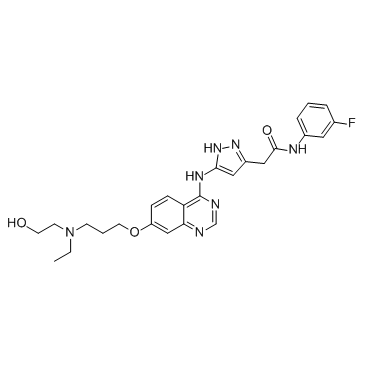
722544-51-6 |
| Literature: ASTRAZENECA AB; ASTRAZENECA UK LIMITED Patent: WO2007/132227 A1, 2007 ; Location in patent: Page/Page column 26; 30 ; WO 2007/132227 A1 |
|
~% 
722544-51-6 |
| Literature: Journal of Medicinal Chemistry, , vol. 50, # 9 p. 2213 - 2224 |
|
~% 
722544-51-6 |
| Literature: Journal of Medicinal Chemistry, , vol. 50, # 9 p. 2213 - 2224 |
|
~% 
722544-51-6 |
| Literature: Journal of Medicinal Chemistry, , vol. 50, # 9 p. 2213 - 2224 |
|
~% 
722544-51-6 |
| Literature: Journal of Medicinal Chemistry, , vol. 50, # 9 p. 2213 - 2224 |
|
~% 
722544-51-6 |
| Literature: Journal of Medicinal Chemistry, , vol. 50, # 9 p. 2213 - 2224 |
| Precursor 7 | |
|---|---|
| DownStream 1 | |
